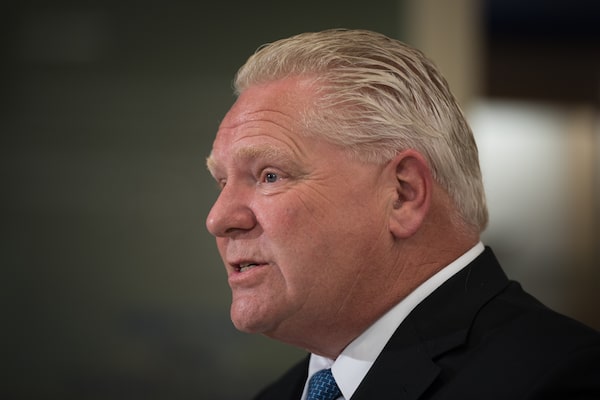
Ontario Premier Doug Ford answers questions following a press conference in Toronto, on Jan. 11.Tijana Martin
Yonge and Eglinton, a midtown Toronto district, has undergone startling changes over the past few decades. When I went to high school there, it was a quiet low-rise residential neighbourhood sprinkled with a few postwar apartment towers. The only tall building at the intersection itself was Canada Square, a 17-storey office complex built in 1962.
As the condominium era dawned, more towers started to rise. Among them were the ground-breaking Minto condos on Yonge, 37 and 52 storeys tall. Neighbourhood associations objected, fearing that the district was turning into something they barely recognized. They fought to limit development and scale back the height of new buildings.
The growth continued all the same. City planners argued, correctly, that, with a major subway stop at its heart, Yonge and Eg was a perfect place to build urban density, a kind of second downtown. This old battle is now entering a new phase.
Determined to tackle Ontario’s housing affordability crisis, the provincial government has vowed to build 1½ million new homes in 10 years. The part of its plan that has drawn the most attention is its push to loosen rules on development in the suburban and exurban parts of Greater Toronto.
Breaking an unequivocal promise not to touch the Greenbelt, the government of Premier Doug Ford is proposing to take 15 parcels of land out of the protected zone and open it up for development. Queen’s Park would also bring in watered-down density targets for suburban municipalities and let them stretch their boundaries, allowing for more housing construction on bordering farmlands.
But there is a second, less-noticed prong of its housing policy. The government is pressing hard to build density around subway, light-rail and GO Transit stations. That makes all kinds of sense. Ontario is in the midst of a huge, multibillion-dollar buildout of its mass transit system. The GO network of regional trains and buses is raising its service levels all the time. New light-rail lines on Eglinton and Finch avenues are nearing completion. Construction is well under way on the government’s signature project, the Ontario Line, a major crosstown subway.
The government aims to encourage building at the big hubs of this growing transit network. It’s called transit-oriented development. Urban planners love it and the government has embraced it with both arms. That’s a very good thing indeed.
Building around transit hubs is good for residents, who get quick access to subways and LRTs and don’t need to rely on their cars as much. That makes their lives a little easier and helps the environment to boot. It is also good for the transit system. Transit lines with dense development around them have more customers, giving them the traffic they need to pay their expenses. A busy transit system is a successful transit system.
The government is pursuing the idea aggressively. That is generating some predictable pushback. Residents groups were upset when they learned of plans to build super-dense transit-oriented communities along a northward extension of the Yonge subway line. The projects would bring dozens of towers and tens of thousands of new residents to the area.
Residents at Yonge and Eglinton are bound to have similar complaints. A few years ago, the government stepped in to overrule a city plan that would have limited the scale of new projects. Since then, The Globe and Mail reported this month, builders have applied to build 700 more storeys of development than the plan would have allowed. The city says the area’s population will now rise to 156,000 by 2051, 20,000 more than expected under the old plan.
That’s a lot of density, but it comes in the right place: an already dense urban hub that will have the Yonge subway running through it one way and the new Eglinton Crosstown light-rail line the other. It’s a lively, dynamic part of town, ideal for those who like a walkable, downtown lifestyle. One of the coming projects, a renewed Canada Square with more towers, will include a big new plaza and public park. Despite all the complaints, the prosperous swaths of single-family homes surrounding Yonge and Eg remain as pleasant and as comfortable as ever, their nature uncorrupted by the nearby thickets of high-rise buildings.
More sprawl is the wrong way to solve Greater Toronto’s housing problem. More density at transit hubs is a much better idea.
 Marcus Gee
Marcus Gee